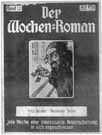
|
|
|

|

|

|

|
|
Click on an image to see a larger, more detailed picture.
|
|
|
|
|
| PROLOGUE: Roots of the Holocaust |

|
pg. 40 |

|
|
|
|
| |
 Such works as this, a weekly 1932 installment of Fritz Reuter's antisemitic novel The Russian Jew, were quite popular with right-wing fanatics.
Such works as this, a weekly 1932 installment of Fritz Reuter's antisemitic novel The Russian Jew, were quite popular with right-wing fanatics.
Photo: Bundesarchiv/ United States Holocaust Memorial Museum Photo Archive
|
 This Polish broadside makes the outrageous, but then popular, claim that "Jews are lice; they cause typhus."
This Polish broadside makes the outrageous, but then popular, claim that "Jews are lice; they cause typhus."
Photo: Historical Museum of Rzeszow / United States Holocaust Memorial Museum Photo Archive
|
|
By 1924, according to Mein Kampf, wherever Hitler saw a threat to the racial and national survival he treasured, wherever he sensed an obstacle to the geographical expansion he craved, he ultimately found the Jews. According to Hitler, Jews plundered, subverted, and infected the very people who deserved to dominate the world. Following Hitler's lead, Nazi propaganda depicted the Jews in at least three major ways at once: as international anti-German conspirators, criminals, and life-threatening pestilence. The German people had to beat back the challenge of these "culture destroyers" once and for all. Under his leadership, Hitler believed, the Nazis would do so by making good their promise of a better life for the German people. As Nazi ideology developed, it understood that way of life to be based on ultranationalism that emphasized German racial "purity" and antisemitism. It also needed a single-party dictatorship and a state-controlled economy, plus ferocious anticommunism and, eventually, aggressive imperialist expansion of German territory through war. Although no one--not even Hitler himself--could know in 1924 the catastrophe that such thinking would create, Hitler's influence and the visibility of the Nazi Party had grown significantly from the most improbable origins. The Nazis were on Germany's political map. Without the Nazis, the Holocaust was unlikely. Without Hitler, neither Nazi domination nor the Holocaust were probable. Without antisemitism, however, Nazism, Hitler's dictatorship, and the Holocaust were plainly impossible. Antisemitism was constitutive of them all. But now issues arise that reach further into the past than Hitler's efforts in Munich during the 1920s, or his experiences in World War I, or his formative years in Vienna. Neither Hitler nor any of his contemporaries were the first to practice what has sometimes been called "the longest hatred." Hitler was born into a world, and specifically into a European environment, in which antisemitism was already present. Not even his racial version of it was novel, although his antisemitic vision definitely produced something completely new: a call for the physical destruction of human beings. Tracing the beginning of the history that moves back from Elie Wiesel's Auschwitz to Fritz Gerlich's spectacles and Hitler's vision requires asking: How did antisemitism arise? What have been the key moments and features in its development? What made it a cause that, if not sufficient to produce the Holocaust, was certainly necessary for that disaster to take place? One approach to that story can start by stepping into the shadow world of pseudoscience and racism.
|
|

|

|

|

|
 July 24, 1922: The League of Nations grants Great Britain a mandate for Palestine, guaranteeing Jewish immigration.
July 24, 1922: The League of Nations grants Great Britain a mandate for Palestine, guaranteeing Jewish immigration.
|
 1922-1933: Two hundred Jewish graves at Nuremberg, Germany, are desecrated.
1922-1933: Two hundred Jewish graves at Nuremberg, Germany, are desecrated.
|
 1923: Rampant inflation throughout Germany makes the nation's currency worthless.
1923: Rampant inflation throughout Germany makes the nation's currency worthless.
|
 1923: The first issue of the pro-Nazi, antisemitic newspaper Der Stürmer (The Attacker) is published in Nuremberg, Germany. Its slogan is "Die Juden sind unser Unglück" ("The Jews are our misfortune"), a phrase picked up from Heinrich von Treitschke.
1923: The first issue of the pro-Nazi, antisemitic newspaper Der Stürmer (The Attacker) is published in Nuremberg, Germany. Its slogan is "Die Juden sind unser Unglück" ("The Jews are our misfortune"), a phrase picked up from Heinrich von Treitschke.
|
 1923: Noted Fascist and antisemite Arthur Moeller van den Bruck publishes Das Dritte Reich (The Third Reich), a book that will become a major influence on Hitler.
1923: Noted Fascist and antisemite Arthur Moeller van den Bruck publishes Das Dritte Reich (The Third Reich), a book that will become a major influence on Hitler.
|
 1923: Jewish homes in Berlin are burned.
1923: Jewish homes in Berlin are burned.
|
|
|
|
|
| PROLOGUE: Roots of the Holocaust |

|
pg. 40 |

|
|
The Holocaust Chronicle
© 2009 Publications International, Ltd.
|
|
